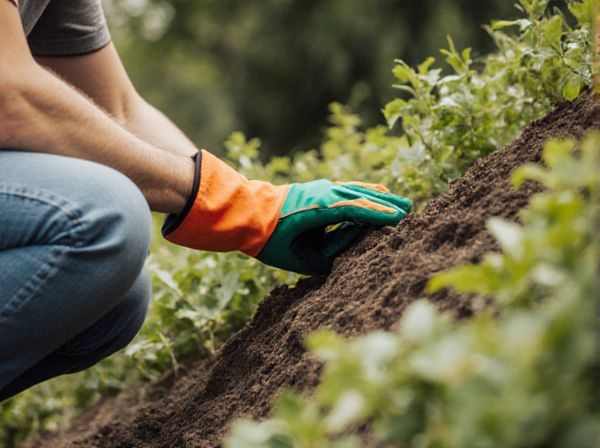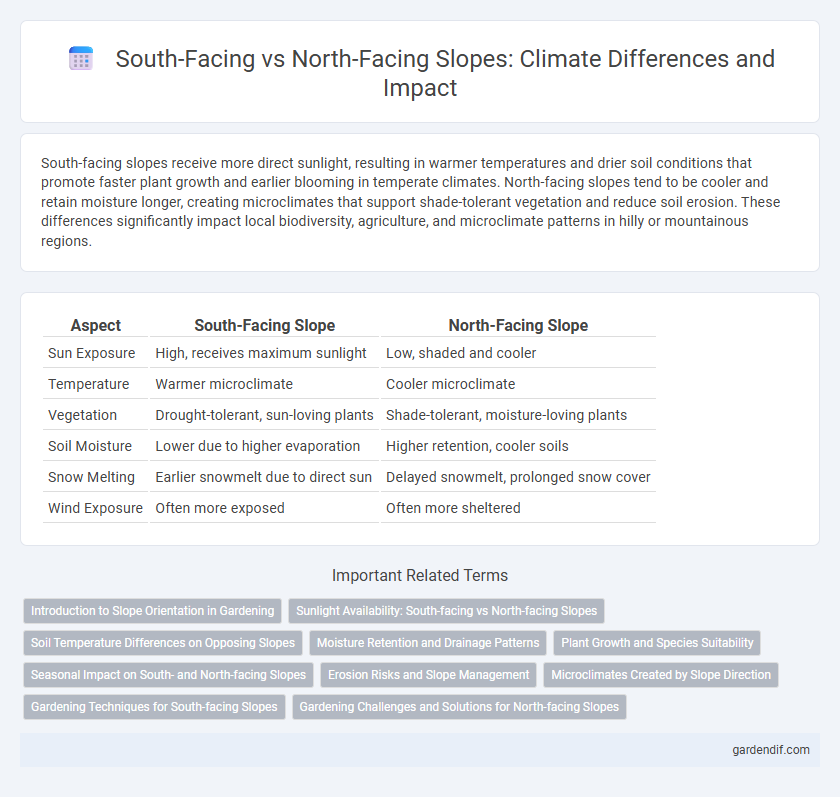
South-facing slope vs North-facing slope Illustration
South-facing slopes receive more direct sunlight, resulting in warmer temperatures and drier soil conditions that promote faster plant growth and earlier blooming in temperate climates. North-facing slopes tend to be cooler and retain moisture longer, creating microclimates that support shade-tolerant vegetation and reduce soil erosion. These differences significantly impact local biodiversity, agriculture, and microclimate patterns in hilly or mountainous regions.
Table of Comparison
| Aspect | South-Facing Slope | North-Facing Slope |
|---|---|---|
| Sun Exposure | High, receives maximum sunlight | Low, shaded and cooler |
| Temperature | Warmer microclimate | Cooler microclimate |
| Vegetation | Drought-tolerant, sun-loving plants | Shade-tolerant, moisture-loving plants |
| Soil Moisture | Lower due to higher evaporation | Higher retention, cooler soils |
| Snow Melting | Earlier snowmelt due to direct sun | Delayed snowmelt, prolonged snow cover |
| Wind Exposure | Often more exposed | Often more sheltered |
Introduction to Slope Orientation in Gardening
South-facing slopes receive more sunlight year-round, creating warmer microclimates ideal for heat-loving plants and extended growing seasons. North-facing slopes retain more moisture and experience cooler temperatures, favoring shade-tolerant and moisture-loving vegetation. Understanding slope orientation helps gardeners optimize plant placement, improve growth conditions, and enhance biodiversity within their landscape.
Sunlight Availability: South-facing vs North-facing Slopes
South-facing slopes receive more direct sunlight throughout the day, resulting in higher solar radiation and warmer temperatures compared to north-facing slopes. This increased sunlight availability promotes earlier snowmelt and longer growing seasons on south-facing slopes. In contrast, north-facing slopes remain cooler and retain moisture longer due to reduced solar exposure, influencing local microclimates and vegetation patterns.
Soil Temperature Differences on Opposing Slopes
South-facing slopes receive more direct sunlight, resulting in higher soil temperatures that accelerate microbial activity and nutrient cycling compared to cooler, shaded north-facing slopes. These temperature differences influence plant growth patterns, with south-facing slopes often supporting species adapted to warmer, drier conditions. Soil temperature variability between opposing slopes is a critical factor in local microclimate regulation and ecosystem biodiversity within hilly or mountainous regions.
Moisture Retention and Drainage Patterns
South-facing slopes receive more direct sunlight, resulting in higher evaporation rates and reduced moisture retention compared to north-facing slopes. North-facing slopes, which are shaded for longer periods, maintain cooler temperatures and greater soil moisture, promoting better moisture retention. Drainage patterns on south-facing slopes tend to be faster due to drier soil conditions, while north-facing slopes generally exhibit slower runoff and enhanced water absorption.
Plant Growth and Species Suitability
South-facing slopes receive more sunlight and warmth, promoting faster plant growth and favoring heat-tolerant and drought-resistant species such as lavender and rosemary. North-facing slopes remain cooler and retain moisture longer, creating optimal conditions for shade-loving and moisture-dependent plants like ferns and mosses. These microclimatic differences influence species distribution, biodiversity, and agricultural planning in different terrains.
Seasonal Impact on South- and North-facing Slopes
South-facing slopes receive more direct sunlight throughout the year, resulting in warmer temperatures and earlier snowmelt that accelerates plant growth during spring and summer. North-facing slopes stay cooler and retain moisture longer, which supports shade-tolerant vegetation and delays soil warming in spring. Seasonal variations in solar radiation create distinct microclimates on each slope, influencing biodiversity and agricultural practices.
Erosion Risks and Slope Management
South-facing slopes experience higher erosion risks due to increased solar radiation leading to drier soil conditions and reduced vegetation cover, which weakens soil stability. In contrast, north-facing slopes maintain higher moisture levels and denser vegetation, providing better natural protection against erosion. Effective slope management practices on south-facing slopes include terracing, mulching, and planting drought-resistant vegetation to minimize soil loss and enhance slope stability.
Microclimates Created by Slope Direction
South-facing slopes receive more direct sunlight, resulting in warmer and drier microclimates that promote faster soil warming and increased evaporation rates. North-facing slopes tend to be cooler and moister due to reduced solar radiation, supporting different vegetation types and slower soil development. These microclimates influence agricultural productivity, plant biodiversity, and local weather patterns, creating distinct ecological niches on each slope orientation.
Gardening Techniques for South-facing Slopes
Gardening techniques for south-facing slopes capitalize on increased sunlight exposure, promoting better warmth and faster soil drying, which benefits heat-loving plants like tomatoes and peppers. Utilizing terracing and contour planting prevents soil erosion and maximizes water retention on the steep incline. Incorporating drought-resistant native species reduces irrigation needs while enhancing biodiversity and climate resilience.
Gardening Challenges and Solutions for North-facing Slopes
North-facing slopes present gardening challenges due to limited sunlight exposure, resulting in cooler temperatures and slower plant growth compared to south-facing slopes. Solutions include selecting shade-tolerant plant species such as ferns, hostas, and astilbes, and improving soil warmth through mulching and raised beds to enhance root development. Incorporating reflective surfaces or light-colored mulch increases light availability, mitigating the effects of reduced solar radiation on North-facing garden areas.
South-facing slope vs North-facing slope Infographic

 gardendif.com
gardendif.com